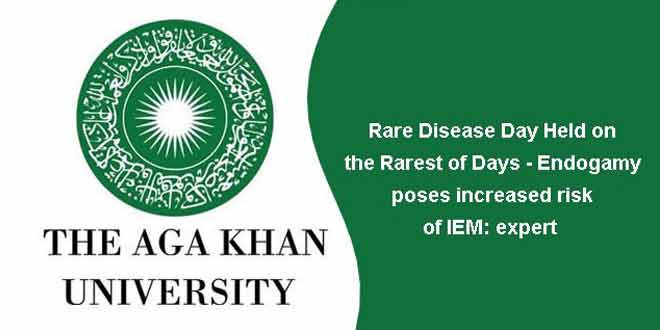
Rare Disease Day Held on the Rarest of Days – Endogamy poses increased risk of IEM: expert
Prominent paediatrician Dr Bushra Afroze said here that the widespread prevalence of intermarriages in Pakistan means that our population is at an increased risk of rare genetic diseases such as inborn errors of metabolism (IEM).
Though, at present, there is very little data in Pakistan on the prevalence of rare diseases, statistics point to a worrying state of affairs, she feared.
Dr Afroze, who is an Assistant Professor at the Aga Khan University, was speaking at a special seminar held under the aegis of AKUH to mark the 9th Rare Disease Day-2016 on Feb 29, the rarest of days on account of the leap year. All around the world, since 2000, the last day of February is set aside as the Rare Disease Day.
Over 200 local practitioners, health advocates and health-care workers attended the seminar.
According to Dr Afroze, the IEM – where newborns lack essential enzymes in the body that can lead to serious complications in a child’s development – are one subset of between 5,000 and 8,000 types of rare diseases that have been detected globally in accordance with the European Medicines Agency.
She said: “In the west the incidence of rare diseases is taken to be 1 in 5,000 births. But in countries where intermarriage is common the incidence rises dramatically. For example in Qatar, where the rate of intermarriages is 40 per cent, cases of rare diseases stand at 1 in 1,300. In Pakistan, the rate of intermarriages is 60 per cent which means that we have only seen the tip of the iceberg when it comes to rare diseases.”
IEM result in babies being unable to break down carbohydrates, fats or proteins. The condition leads to toxic substances accumulating in their bodies that can cause complete developmental arrest and even early death, unless the disease is diagnosed, quickly.
It may be pointed out that in 2013 the city’s Aga Khan University Hospital (AKUH) became the only hospital in Pakistan to offer diagnostic testing services for treatable IEMs. Previously, the same samples would have to be sent abroad for diagnosis.
With diagnostic facilities now available in Pakistan, metabolic errors can be detected quicker and managed promptly through dietary modification. In just two years, 88 cases have been positively diagnosed from 1,866 specimens received in AKUH from all over Pakistan.
Dr Aysha Habib Khan also highlighted the challenges to the progress of diagnosing IEMs in Pakistan such as huge disparities in ethnic populations, the high prevalence of malnutrition and infections, the co-existence of very different models of public health services, unstable socio-economic and political conditions, and the difficulties in integrating the various stakeholders.
“Mothers will present to their obstetricians with a history of recurrent miscarriages or loss of child in early childhood. Affected children usually suffer from common and non-specific symptoms: repeated infections, failure to gain weight, seizures or fits, and if left untreated with cerebral palsies.”
She added that a multi-disciplinary approach was essential to improving treatment outcomes for IEMs: “Desired outcomes can only be achieved through a close liaison among paediatricians, chemical pathologists, dieticians and metabolic specialists.”
Globally, diagnostic advances have led to the identification of more than 5,000 rare diseases. More than ever before, rare diseases are receiving recognition from clinicians and government funding agencies alike, she added.
Source: Medical News Pakistan

